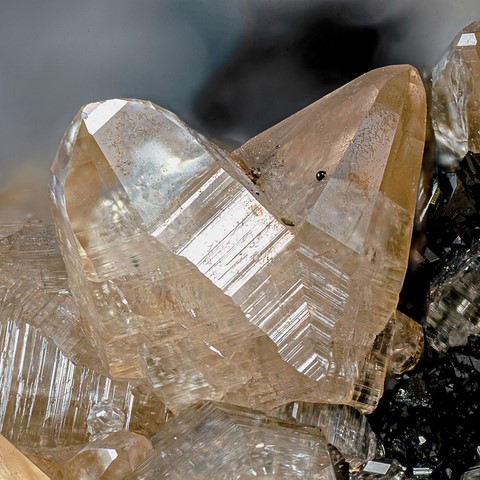CLINOHUMITE
Class : Silicates
Subclass : Nesosilicates
Crystal system : Monoclinic
Chemistry : Mg9(SiO4)4(F,OH)2
Rarity : Common
Clinohumite belongs to the humite group, which also includes chondrodite and humite. It is a mineral typical of limestones and dolomites affected by contact metamorphism caused by plutonic and alkaline rocks which transformed them into cipolins or marbles, with the accompanying formation of skarns. As with chondrodite, the genesis of clinohumite also requires significant metasomatism (fluorine contribution). Clinohumite is also observed, like chondrodite, in blocks of metamorphosed limestone rejected by Italian volcanoes (beautiful, perfectly formed crystals at Vesuvius and Mount Somma, near Naples). Its name is related to its monoclinic structure and its chemical similarity with humite. Clinohumite crystals form rounded grains with a cracked appearance, more rarely isometric or tabular individuals, rich in faces, with shapes reminiscent of olivine, generally not exceeding 1 cm. Twins and aggregates are common. The color ranges from yellow-orange to red-brown, even brown. Gem crystals are commonly cut for jewelry.
Main photo : Clinohumite from Kukh-i-Lal, Pyandzh River Valley, Gorno-Badakhshan, Tajikistan © Oleg Lopatkin
Clinohumite in the World
Twinning
A twin is known on {100}, simple or lamellar.
Fakes and treatments
No fake identified for this mineral species.
Hardness : 6
Density : 3.17 to 3.35
Fracture : Irregular to sub-conchoidal
Streak : White-gray
TP : Translucent to transparent
RI : 1.623 to 1.728
Birefringence : 0.028
Optical character : Biaxial +
Pleochroism : Visible
Fluorescence : None
Solubility : Acids
Magnetism : Paramagnetic
Radioactivity : None





